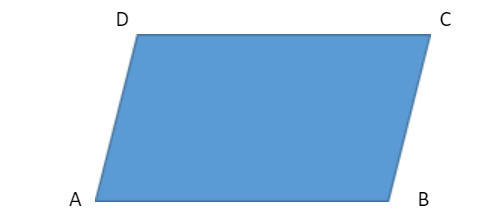
Answer
497.1k+ views
Hint: First name the coordinates of all the vertices of the parallelogram. Find the coordinates of mid-points of the diagonal using the coordinates of the vertices. Since it’s a parallelogram, coordinates bisect each other, hence, equate both coordinates of midpoint obtained from two diagonals and then proceed.
Complete step-by-step answer:

Let A(1,2), B(4,y), C(x,6) and D(3,5) are the vertices of a parallelogram ABCD
AC and BD are the diagonals.
O is the mid-point of AC and BD
The coordinates of mid-point are given by \[\left[ {\dfrac{{{x_1} + {x_2}}}{2},\dfrac{{{y_1} + {y_2}}}{2}} \right]\]
If O is the mid - point of AC, then the coordinates of O are =\[\left( {\dfrac{{1 + x}}{2},\dfrac{{2 + 6}}{2}} \right) = \left( {\dfrac{{x + 1}}{2},4} \right)\]
If O is the mid-point of BD then coordinates of O are=\[\left( {\dfrac{{4 + 3}}{2},\dfrac{{5 + y}}{2}} \right) = \left( {\dfrac{7}{2},\dfrac{{5 + y}}{2}} \right)\]
Since both coordinates are of the same point O
∴ \[\dfrac{{1 + x}}{2} = \dfrac{7}{2}\]
\[ \Rightarrow 1 + x = 7\]
\[x = 7 - 1 = 6\]
∴\[\dfrac{{5 + y}}{2} = 4\]
\[ \Rightarrow 5 + y = 8\]
\[ \Rightarrow y = 8 - 5 = 3\]
Hence, x = 6 and y = 3.
Note: Following are the properties of Parallelogram are:
Opposite sides are parallel.
Opposite sides are congruent.
Opposite angles are congruent.
Consecutive angles are supplementary.
Diagonals intersect each other.
Complete step-by-step answer:

Let A(1,2), B(4,y), C(x,6) and D(3,5) are the vertices of a parallelogram ABCD
AC and BD are the diagonals.
O is the mid-point of AC and BD
The coordinates of mid-point are given by \[\left[ {\dfrac{{{x_1} + {x_2}}}{2},\dfrac{{{y_1} + {y_2}}}{2}} \right]\]
If O is the mid - point of AC, then the coordinates of O are =\[\left( {\dfrac{{1 + x}}{2},\dfrac{{2 + 6}}{2}} \right) = \left( {\dfrac{{x + 1}}{2},4} \right)\]
If O is the mid-point of BD then coordinates of O are=\[\left( {\dfrac{{4 + 3}}{2},\dfrac{{5 + y}}{2}} \right) = \left( {\dfrac{7}{2},\dfrac{{5 + y}}{2}} \right)\]
Since both coordinates are of the same point O
∴ \[\dfrac{{1 + x}}{2} = \dfrac{7}{2}\]
\[ \Rightarrow 1 + x = 7\]
\[x = 7 - 1 = 6\]
∴\[\dfrac{{5 + y}}{2} = 4\]
\[ \Rightarrow 5 + y = 8\]
\[ \Rightarrow y = 8 - 5 = 3\]
Hence, x = 6 and y = 3.
Note: Following are the properties of Parallelogram are:
Opposite sides are parallel.
Opposite sides are congruent.
Opposite angles are congruent.
Consecutive angles are supplementary.
Diagonals intersect each other.
Recently Updated Pages
Fill in the blanks with suitable prepositions Break class 10 english CBSE

Fill in the blanks with suitable articles Tribune is class 10 english CBSE

Rearrange the following words and phrases to form a class 10 english CBSE

Select the opposite of the given word Permit aGive class 10 english CBSE

Fill in the blank with the most appropriate option class 10 english CBSE

Some places have oneline notices Which option is a class 10 english CBSE

Trending doubts
Fill the blanks with the suitable prepositions 1 The class 9 english CBSE

How do you graph the function fx 4x class 9 maths CBSE

When was Karauli Praja Mandal established 11934 21936 class 10 social science CBSE

Which are the Top 10 Largest Countries of the World?

What is the definite integral of zero a constant b class 12 maths CBSE

Why is steel more elastic than rubber class 11 physics CBSE

Distinguish between the following Ferrous and nonferrous class 9 social science CBSE

The Equation xxx + 2 is Satisfied when x is Equal to Class 10 Maths

Differentiate between homogeneous and heterogeneous class 12 chemistry CBSE




